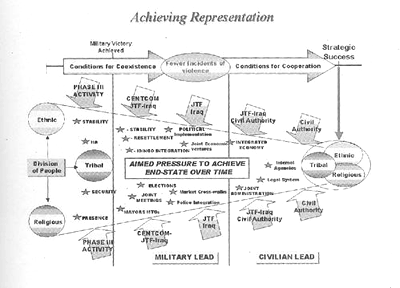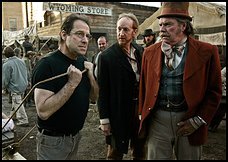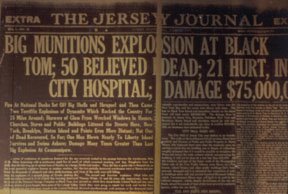
This is a PowerPoint slide from "an official Central Command briefing depicting how the United States intended to progress from 'military victory' to 'strategic success.'"
Before commenting on this horror, I have to make a confession. For several years during the late Eighties and early Nineties, I ran a corporate communications graphics and pubs shop for a Beltway Bandit in the Washington suburbs, during which I came to detest Microsoft's PowerPoint with a hatred I reserve for few things in this world -- it falls somewhere between my loathing for Dick Cheney and Virginia Senator George Allen. But my confession is this: I too have perpetrated information-design horrorshows like the one above. In my defense, the ideas didn't come from my own head but from pointy-haired bosses whose lives depended on communicating with military procurement officials -- and here's the important part -- in their own language.
And above you see the language that these people speak. My sudden, unexpected reimmersion into the clouds of toxic methane and voice-ensqueakening helium emitted by a DOD PowerPoint deck was what sent me scurrying under the bed, promising to be a good boy and never anger Mommy again.
Now, to the PowerPoint graphic itself.
First, let me say, that although it's unrelievedly ugly, stuffed with Tuftean "chart-junk" like meaningless grayscale fades and pointless drop-shadows, dismally unimaginative default typefaces, and hilariously underthought all-caps Pentagon-ese ("aimed pressure to achieve end-state over time"), the chart isn't completely incomprehensible. In fact, a reasonably well crafted paragraph will summarize every point made in the chart. Let's try a retranslation:
The difficulty we will face upon invasion will be a division of the people of Iraq along ethnic, tribal and religious lines. Our task will be to reduce these divisions to form a cohesive whole, which will, in theory, lead to a healthy democratic society. Our expectation is that once we are able, through improved policing procedures, to reduce the incidents of violence attendant on invasion, what was once mere coexistence will lead to cooperation and strategic success. We expect the occupation to occur in three phases: first the invasion itself; a second period in which the US military will govern the country; and a final phase in which Iraqi civilians will assume leadership. During the first phase, we will establish a visible presence and assume responsibility for security and stability. In the second phase, the combined forces of CENTCOM and the Joint Task Force-Iraq will apply pressure to form a government, begin reconciliation among local authorities, and continue to provide stability. In the final phase, responsibility for this pressure will revert to the civil authorities, and we expect a civil society to emerge, and the ethnic, tribal and religious tensions to abate.And we all know how well that turned out.
The problem with the Pentagon PowerPoint graphic is this: It reduces the monstrously complex problem of invading and occupying a nation-state to a (gigantic, tortured, overwrought) visual metaphor. Those ugly-assed arrows, representing CENTCOM, JTF Iraq and so forth, make the application of "pressure" on the forces of disorder look like some kind of marvelous deus ex machina that will somehow magically turn the centrifugality of post-invasion anarchy into the centripetality of pre-democratic order. That visual metaphor, on first glance so imposing, so inevitable, is in reality a deeply evil and dissembling disguise.
Look again at my paragraph summarizing the graphic. It's absolutely full of holes, of logical lacunae. Are those the true dividing lines in Iraq society, or are the tensions and loyalties more complex than that? What does this "pressure" consist of? What if there is resistance? What is the mechanism by which forced coexistence leads to cooperation? What if the Iraqi civilian leadership has ulterior motives in presenting itself as such? How is reconciliation among local governing forces going to be achieved? How does the newly constituted civil authority view this unearned responsibility for continuation of US military policy? What if there aren't enough troops?
The guys we got running the joint are busy, busy people. They've got no time for reading a paragraph of the complexity I just presented. They need it boiled down, they need it condensed, so they understand your point in a quick glance. You present Rummy with a graf like that, he's gonna throw your beautifully crafted prose out the window of his limo, you overheated stripey-pantsed Ivy-League pinhead! When you're ushered into his presence, you've got eight seconds to get his attention, and if you don't grab him by the short-and-curlies in that time, he's gonna rip your head off and piss down your neck!
Do you expect Rummy to brief the President of the United States with that shit?
Others have blamed PowerPoint itself for the stupefaction of American government. I won't go that far -- software can't make you do anything you weren't already going to do. The simple fact remains that the logical holes in my prose paragraph went unchallenged by the very people whose entire function it is to issue those challenges. They bought the graphic, not the paragraph.
I don't blame PowerPoint. I blame a country that interprets intellectual laziness as "swagger." I blame a country that allows PowerPoint presentations to substitute for actual verbal discourse at the highest levels of government and commerce. I blame a country that rewards incompetence, that expects less and less engagement in inconvenient detail the higher you ascend the ladder -- the higher you go the less you're expected to know -- until you reach the pinnacle, where the mighty and revered godhead knows absolutely nothing at all.













